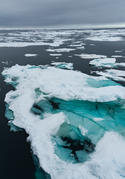An Ocean Conveyor Belt
One tipping point, hidden away in the ocean, could bring a mini ice age to Europe. It sounds counter-intuitive, a regional ice age in the midst of global warming but if Greenland’s ice continues to melt, it’ll probably happen.

The Gulf Stream is a massive body of warm, salty water which moves from the Gulf of Mexico across the Atlantic and past Scotland, delivering tremendous amounts of heat to northern latitudes that would otherwise be a great deal colder (compare Europe’s climate with Canada at the same latitude).
When water, delivered by Gulf Stream, arrives at Greenland it is high in salinity because evaporation along its journey has caused it to become more salty. Once it reaches high into the North Atlantic, it cools down.
The saltiness and cold forces the current to sink down towards the ocean floor, whereupon it begins a long journey south to the Antarctic. This is part of the larger thermohaline circulation, the “global conveyor belt”, which distributes energy around the globe and drives the planet’s climate.
It’s Happened Before

Flush too much fresh water into the head of the Gulf Stream, and the water becomes less salty and thus won’t be forced to sink. This would stall the conveyor belt and stop the delivery of heat to the region, something which has happened in the geological past. There is now evidence to suggest that the Gulf Stream’s salinity is decreasing and its circulation has slowed by almost a third between 1957 and 2004.
If Greenland, the world’s second largest ice cap, dumps too much fresh water into the head of the Gulf Stream, Western Europe descend into a mini ice age, the likes of which were last seen during the Little Ice Age. This is unlikely to happen within the next century, but could happen further in the future.
By Leonie Joubert